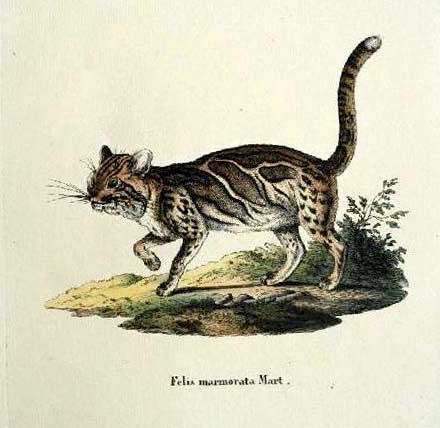Pardofelis marmorata Cladus: Eukaryota Name Pardofelis marmorata Martin, 1837 Vernacular names References * Pardofelis marmorata on Mammal Species of the World. The Marbled Cat (Pardofelis marmorata) is a small wild cat of South and Southeast Asia. Since 2002 it has been listed as vulnerable by IUCN as it occurs at low densities, and its total effective population size is suspected to be fewer than 10,000 mature individuals, with no single population numbering more than 1,000.[2] The species was once considered to belong to the pantherine lineage of "big cats".[3] Genetic analysis has shown that it is closely related with the Asian Golden Cat and the Bay Cat, all of which diverged from the other felids about 9.4 million years ago.[4] Characteristics
The fur is blotched and banded like a marble, usually compared to the markings of the much larger Clouded Leopard. In colour, the base fur ranges from pale yellow through to brownish grey with lighter underparts. There are dark spots on the legs, underparts, and forehead, with bands on the tail and stripes on the neck and along the middle of the back. There are also white bands on the backs of the ears.[5] In addition to its long tail, the marbled cat can also be distinguished by its large feet, a feature it shares with the Clouded Leopard. It also possesses unusually large canine teeth, resembling those of the big cats, although these appear to be the result of parallel evolution.[5] Distribution and habitat Marbled cats are found in tropical Indomalaya westward along the Himalayan foothills westward into Nepal and eastward into southwest China, and on the islands of Sumatra and Borneo. They are primarily associated with moist and mixed deciduous-evergreen tropical forest.[2] Two subspecies are recognized:[6] * Pardofelis marmorata marmorata described by William Charles Linnaeus Martin in 1837 — lives in Malay Peninsula, Sumatra, Borneo northward to Myanmar;
In May 2000, a female marbled cat was trapped along an animal trail in a hill-evergreen / bamboo mixed forest in Thailand's Phu Khieo Wildlife Sanctuary. This first-ever radio-tracked marbled cat had an overall home range of 5.8 km2 (2.2 sq mi) at an elevation of 1,000 to 1,200 m (3,300 to 3,900 ft) and was active primarily during nocturnal and crepuscular time periods.[7] It is probable that forest canopies provide the marbled cat with much of its prey: birds, squirrels, other rodents and reptiles.[5] A few marbled cats have been bred in captivity, with gestation estimated at between 66 and 82 days. In the few recorded instances, two kittens were born in each litter, and weighed from 61 to 85 g (2.2 to 3.0 oz). The eyes open at around twelve days, and the kittens begin to take solid food at two months, around the time that they begin actively climbing. Marbled cats reach sexual maturity at 21 or 22 months of age, and have lived for up to twelve years in captivity.[5] Conservation It is rarely sighted in its densely forested habitat, and little studied or understood. Its population is estimated at below 10,000 mature individuals. Its forested habitats have been shrinking, accounting for its vulnerable listing in IUCN.[2] The only captive marbled cats registered by ISIS are a pair kept at a breeding center in the United Arab Emirates.[8] References 1. ^ Grubb, Peter (16 November 2005). Wilson, Don E., and Reeder, DeeAnn M., eds. ed. Mammal Species of the World (3rd ed.). Baltimore: Johns Hopkins University Press, 2 vols. (2142 pp.). ISBN 978-0-8018-8221-0. OCLC 62265494. http://www.bucknell.edu/msw3/browse.asp?id=14000177. Source: Wikipedia, Wikispecies: All text is available under the terms of the GNU Free Documentation License |
|


